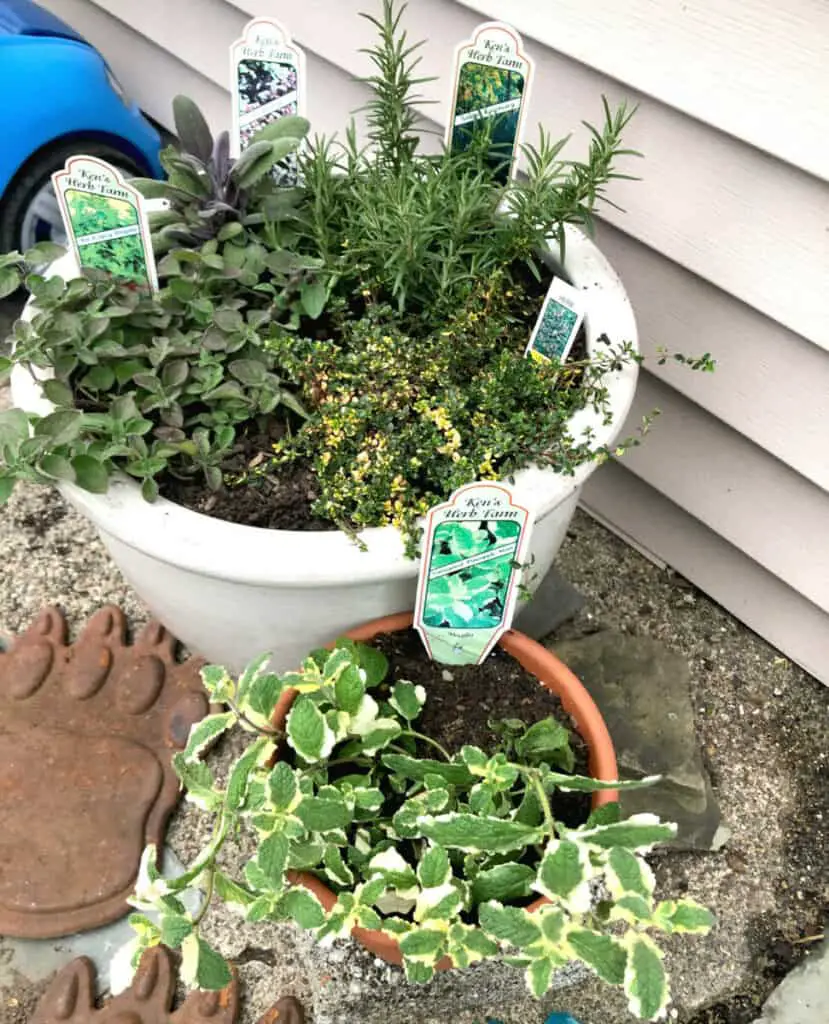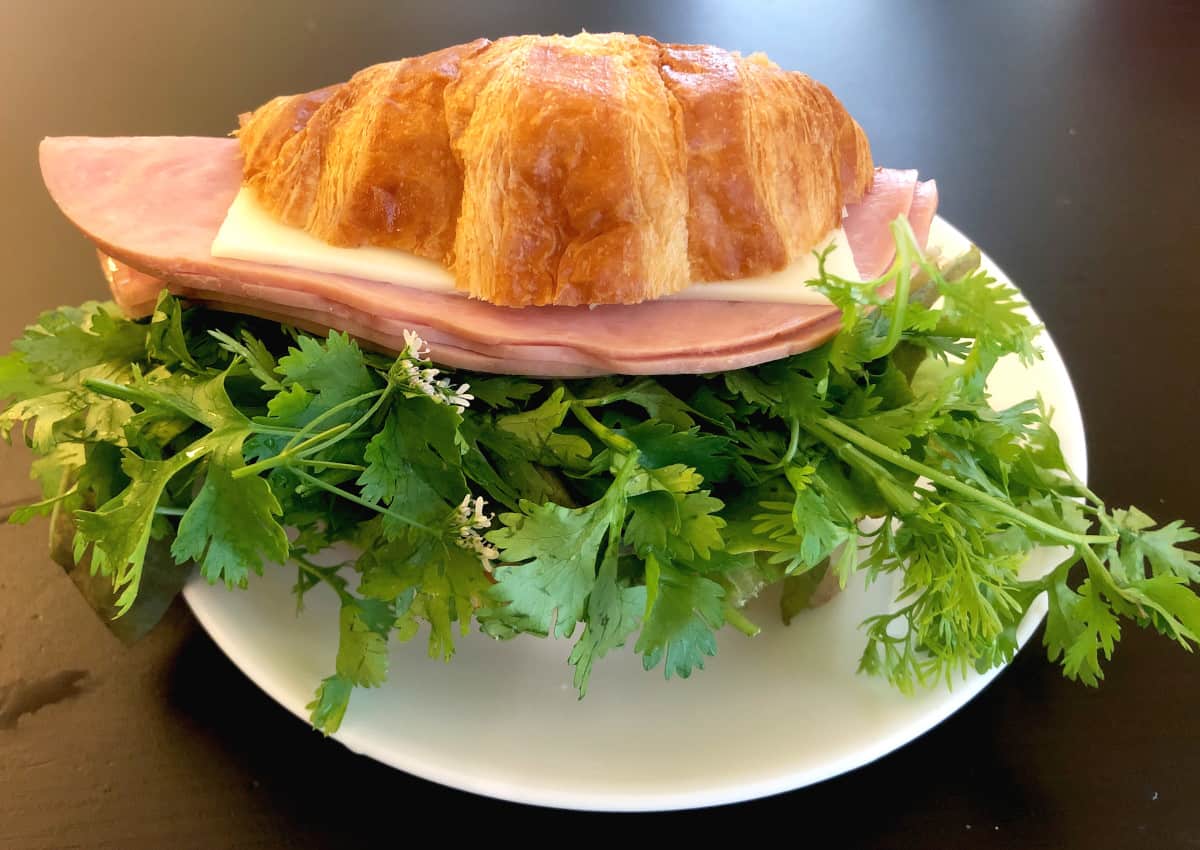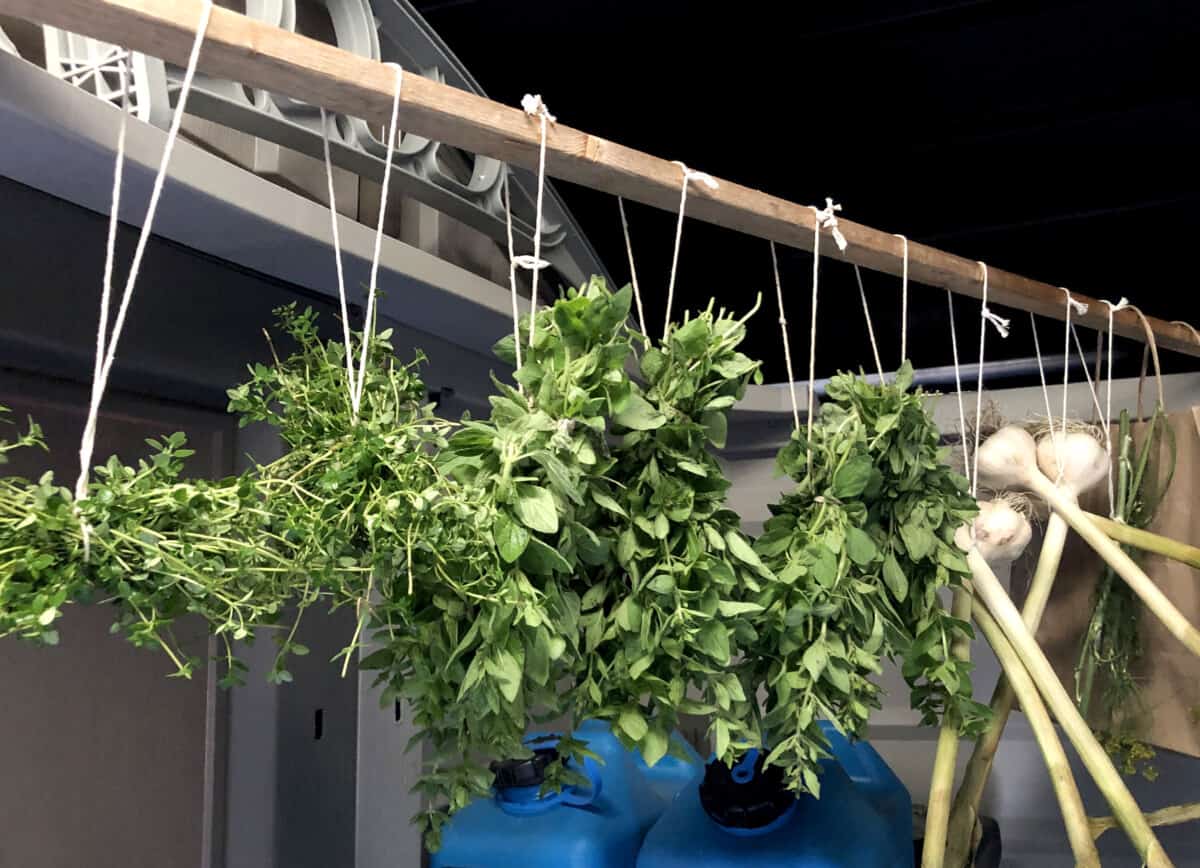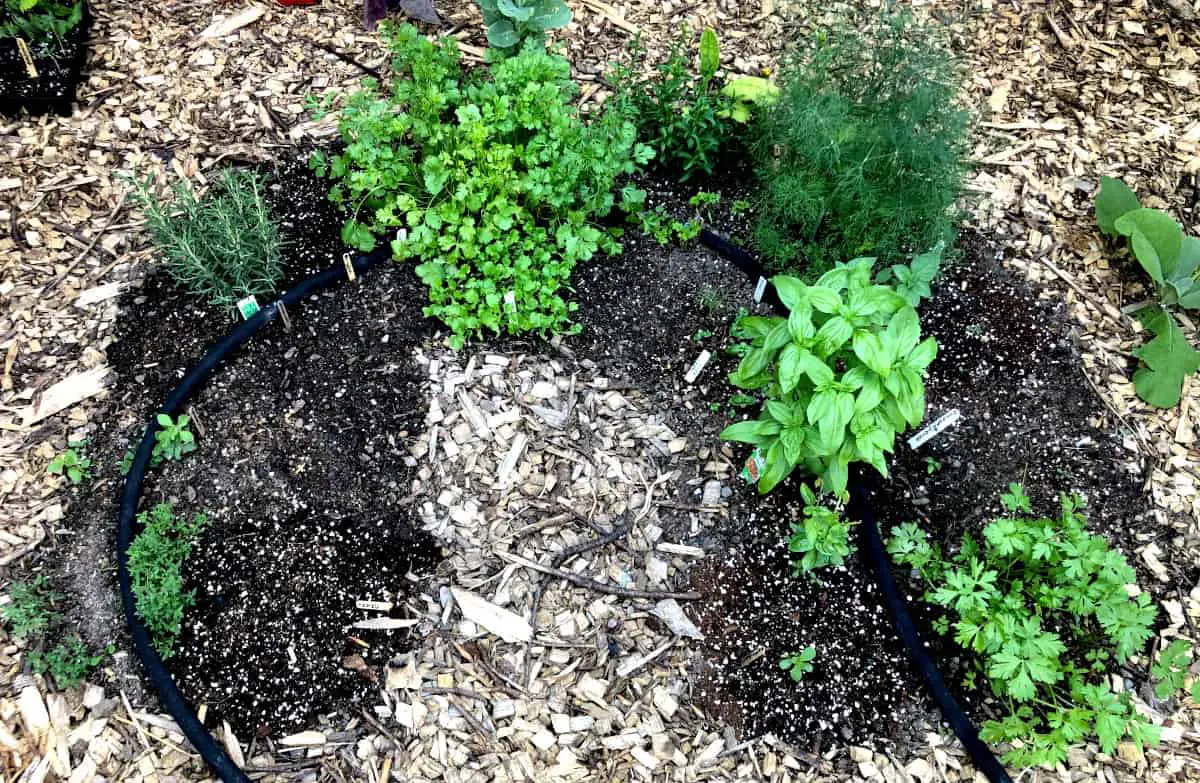A vegetable garden without herbs is not a complete garden. And I can’t even imagine cooking without herbs! If you love herbs as much as I do, then surely you have your favorite bunch! Herbs are very beginner-friendly plants and add not only a fresh look to any garden but also a scent. Just try to pass by mint without touching it, well, impossible!
You should grow herbs because they add immense flavor, and fragrance to the meal and elevate the plating. Colorful herbs make your dishes stand out as they look pretty. Herbs are expensive to buy but inexpensive and easy to grow. They are great plants to start with for beginner gardeners. Store-bought fresh herbs wilt and go bad relatively quickly compare to fresh potted herbs which last the whole growing season. In fact, you don’t need a yard to grow herbs, they are very compact and do not take much space to grow. They are great plants for containers and limited spaces like balconies or patios. They will do great on a sunny windowsill indoors. Just try to cook a savory meal and add your favorite herbs to one serving and no herbs to the other. Each serving will taste very different, one will taste bright and fun while the other serving will taste just regular. Don’t know what gift to buy for a person who has it all? Live herbs in a lovely pot or container is always a great choice!

What are herbs
Herbs are aromatic or savory edibles of which leaves, seeds and flowers can be used for flavoring food, medicinal purposes, or perfume.
What are the most used herbs?
The most used and most popular herbs are basil, rosemary, thyme, cilantro, dill, mint, oregano, parsley, sage, bay leaf, marjoram, chives, tarragon, sorrel, lemon balm, fennel, nasturtium, lovage, lemongrass, lavender, anise hyssop.
How are herbs used
Herbs can be used in culinary to provide flavor, fragrance, and color. They are also used to be infused in herbal teas. Herbs have been long used in medicine, cosmetics, and aromatherapy.
How to use herbs in cooking
Whole herbs can be added to meals whole at the beginning of cooking to release flavor. For example, when cooking sauces, chili, soups, broth, and stew.
When herbs are chopped or torn open their flavor and aroma are immediately released and they are mostly used fresh as garnishes to meals, desserts, toppings to salads, and in sandwiches.

It is a lot of fun cooking and baking with herbs as each herb has a different flavor, color, and aroma profile. I would like to encourage you to experiment with different herbs to get to know a handful of them. Then choose a bunch of those that suit your cooking style best and then carry them in your garden as perennial or annual plants and of course dry them to store them in your pantry.
There are herbs that pair well with savory food and herbs that pair well with sweet dishes, and some pair well with both.
To flavor savory food use basil, rosemary, thyme, cilantro, oregano, parsley, sage, bay, marjoram, chives, tarragon, sorrel, fennel, nasturtium and lovage.
Herbs that go well with sweet dishes like deserts are often used mint, lemongrass, sorrel, tarragon, lemon balm, fennel, lavender, thyme, basil, rosemary, and anise hyssop.
Herbs that are very versatile and suitable for both, savory and sweet dishes are mint, lemongrass, sorrel, tarragon, fennel, thyme, basil, and rosemary. If you are short on space and looking for herbs that can be utilized the most these versatile herbs would be the ones to go with as they can be used to prepare main savory meals as well sweet deserts.
I also tried tarragon, marjoram, lavender, sorrel, and nasturtium but these didn’t work in my cooking at all. Now I use sorrel as a novelty herb to tear and eat as I pass it by or as a talking point to surprise visitors to my garden with the punching flavor of sorrel. I started to grow sorrel because it is the herb of my childhood and brings lots of nostalgic memories. You also might have that special herb that perhaps your grandmother grew in her garden or used in her dishes or the one you used to munch on while running around with your friends, perhaps it was sorrel too!
How to store herbs
Herbs can be easily dried or dehydrated by tying them with a string and hanging them upside down to dry. They can store for months before use in plastic or glass bottles or bags. Then they are added to meals as they are being prepared during which process, they rehydrate or can be also used in their dry form as a topping.

Herbs can also be preserved by freezing them. Individual leaves can be frozen in airtight bags or containers. I like to freeze mine chopped and placed in ice trays and coved with oil. I like to add my frozen herbs in oil at the beginning of cooking meats, fish, or when roasting veggies. They add a punch of flavor to any one-sheet pan dinner. They can be mixed in with rice right before cooking and added to buttery mashed potatoes.
How to harvest herbs
Some herbs can be harvested and used whole including stems, leaves, and flowers. Others are best using their leaves only, they can be pinched or cut with scissors or a sharp knife.
Herbs in my garden are cut and come again. I pinch or cut them off as much as needed fresh for cooking and in large amounts for drying to fill my pantry with. Then I give them about two weeks to regrow before I come to harvest them again. Not all herbs are my favorite, I tried a bunch and picked the ones I and my family enjoy most. My favorite and must-have pantry staples are cilantro, basil, dill, thyme, rosemary, oregano, lovage, parsley, and mint.
This is how I harvest my cut and come again herbs. I pinch leaves along with stems off of cilantro and parsley, leaving the baby leaves closest to the ground and root to regrow new leaves. I pinch tips of rosemary, stems with leaves of thyme and oregano leaving roots intact for regrowth. I pinch the largest leaves on the stem off of the basil plant and leave the small leaves on to grow some more for more harvest.
How to propagate herbs
Some herbs are very easy to propagate. I found basil is the easiest one. When basil side-shoots branches are about 2 inches tall, I snip them off and plant them directly in the ground, water them and they set roots in a couple of days. You just got a new basil plant for more production! It’s easier and faster to propagate basil than growing it from seed all over.
Mint is also easy to propagate, using the same technique as described for the basil plant.
Herbs like rosemary can also be propagated from cuttings but since they have woody stems it can be tricky. To propagate rosemary from cutting, choose a stem from the mother plant that is young with new growth, about 2 inches tall, soft to bend on top but woody at the bottom. Cut the shoot off of the mother plant. Strip the lower leaves off and place the stem in about 1 inch of water. Change water daily or at least every other day. Once the shoot grows roots plant it in soil. Cilantro and dill are fast-growing herbs and I like to sow them in succession. Dill is great for pickling and fermenting. Basil doesn’t grow as fast in my garden when grown from seed, therefore I prefer to propagate it from cuttings as I described above, it’s much faster and more reliable.
How to grow herbs from seed
Fill your preferred container with your preferred potting soil. Moisten it and place the seed of the herb in about 0.4 inches deep. Cover with soil and moist with a spray bottle. Place in a dark and warm place. Once your seed has sprouted and the first leaves start to show, place the container on a sunny windowsill or under grow light and provide it with plenty of light.
Herbs do well being planted directly outdoors once temperatures are above 40F at night. Dill, cilantro, and basil do very well direct seeded. They take only about 4-8 weeks from seed to harvest.
Rosemary and thyme require much more time from seed to harvest. Thyme is especially slow to germinate and can take up to 28 days to do so. While Rosemary is a woody plant and therefore very slow to grow and establish. Therefore I recommend buying some herbs and some to grow from seed.

I tend to buy slow-growing herbs already established, like thyme and rosemary, while other fast-growing herbs such as dill, and cilantro I sow in succession through the whole growing season. When it comes to basil, I sow some and also buy some established plants and propagate them from cuttings while I wait for my seeds to germinate.
In my zone 6, four perennial herbs come back every year in my garden. It is my two favorite thyme and oregano. The other two I don’t particularly care for are tarragon and lavender, which I have in my garden for beautiful flowers. These are hardy perennials in my zone 6. Unfortunately, none of the rosemary I bought lasted through the winter. I am still on the lookout for THE ONE that will make it through winter while being left outdoors.
Some herbs are self-seeding, like dill and cilantro. If you leave their seed on the plant and let the plant die in the same spot over the winter you have a good chance that the seeds overwinter and new plants will grow from them. Cilantro and dill do overwinter their seeds in my zone 6.
Some herbs are biennial plants, which means they last in your garden for 2 years. Parsley is a good example of a biennial herb. Biennial plants grow roots and leaves the first year and then also flowers and go to seed the second year. I plant parsley every year because there is never enough parsley in my garden. In the second year I also like to harvest the roots, so the more I sow the more root I can harvest. Parsley root tastes very similar to parsnip but is much smaller in size. It’s fragrant and bright with a floral scent. Yum!
What herbs come back every year?
What herbs do not come back next year?
Best staple foods to grow in a garden
Most high-yielding fruits and vegetables to grow in pantry stocking garden

